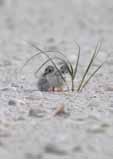Share The Shore – With Least Terns
 With more people living and playing along Florida’s shoreline, sharing and protecting beach resources becomes an increasing challenge. As many snowbirds head north for the summer, a bird species that arrives on area beaches every spring is the least tern (Sternula antillarum). Due to its declining population the least tern is listed as a Threatened species by the Florida Fish and Wildlife Conservation Commission and (FWC) and protected by the federal Migratory Bird Treaty Act.
With more people living and playing along Florida’s shoreline, sharing and protecting beach resources becomes an increasing challenge. As many snowbirds head north for the summer, a bird species that arrives on area beaches every spring is the least tern (Sternula antillarum). Due to its declining population the least tern is listed as a Threatened species by the Florida Fish and Wildlife Conservation Commission and (FWC) and protected by the federal Migratory Bird Treaty Act.
Least terns are winter residents in Central and South America, and return to our beaches each spring to nest and raise their young. They lay their eggs directly on the sand and require beaches with sparse vegetation.
Least terns nest together in colonies and lay their eggs in shallow scrape nests they make in the sand, however their well-camouflaged eggs and chicks can be trampled by unwary beachgoers. If repeatedly disturbed by nearby people, dogs or vehicles, entire least tern colonies can fail as adult birds are continually flushed off their nests leaving vulnerable young to the elements and predators.
In cooperation with the FWC, Collier County Audubon, and the City of Marco Island, Rookery Bay National Estuarine Research Reserve annually closes several acres of barrier island beach each summer to minimize impacts on nesting birds from human activity.
Posted areas within the Reserve include an emergent sandbar southeast of Cape Romano called “Second Chance” and the extreme south end of Key (Keewaydin) Island.
FWC and partners post the area north of Tigertail Beach known as “Sand Dollar.”
Reserve staff and Team OCEAN volunteers post educational signs connected by yellow string tied with bright orange flagging to alert beach visitors to avoid least tern colony nesting areas.
Protection of nesting colonies early in the season is crucial. As the summer progresses, coastal areas have increased risk of being overwashed by severe storms and high tides.
A combination of posting and closure, law enforcement presence, and visitor awareness is necessary to ensure beach-nesting bird reproductive success.
When you visit the beach, do your part to help protect this Threatened species:
• Respect posted areas and keep your distance from nesting birds and
chicks
• Leave your pets at home, on your boat, or on a leash
• Don’t leave any litter or food behind – this can attract nest predators
• Never deploy fireworks at or near an active nesting area
• Report violations to FWC’s Wildlife Alert Hotline: 888.404.3922
Rookery Bay National Estuarine Research Reserve encompasses 110,000 acres of coastal lands and waters between Naples and Everglades National Park. It is managed by the Florida Department of Environmental Protection’s Coastal Office in cooperation with NOAA.
For more information visit www.rookerybay.org.

Leave a Reply
Want to join the discussion?Feel free to contribute!